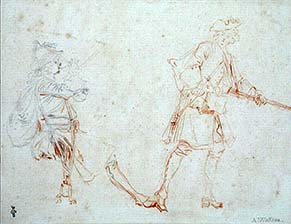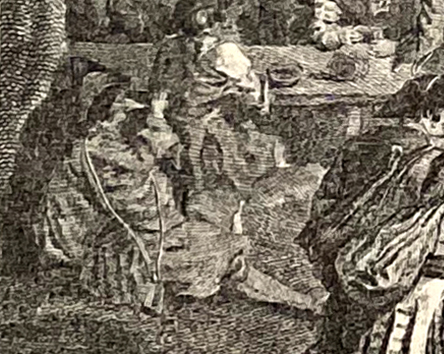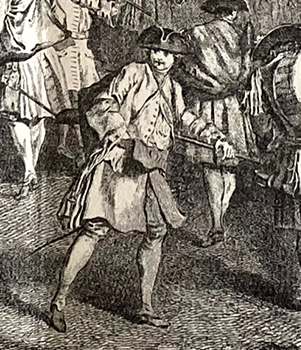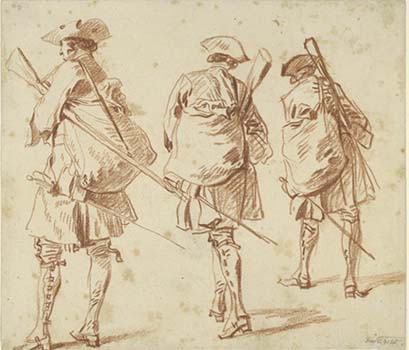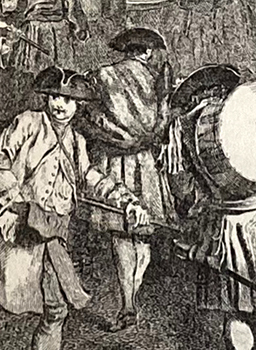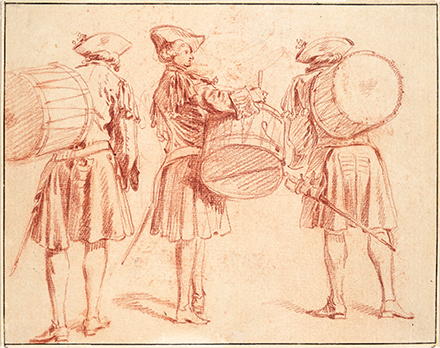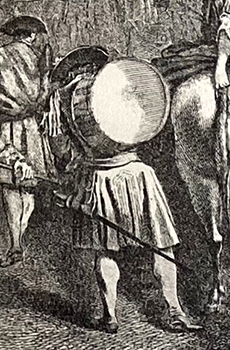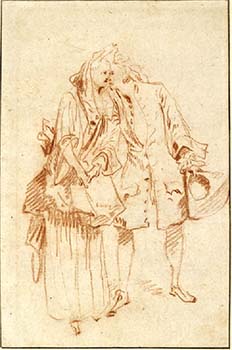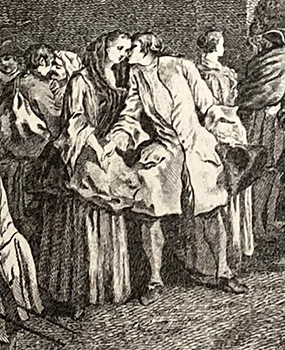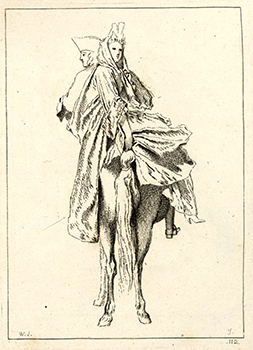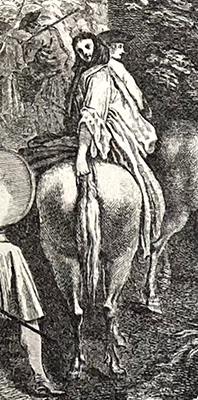
- Home Page
- Accepted
Paintings & Copies - Doubtful
Attributions - Doubtful Textual References
- Alternative
Titles - Collectors &
Museums - Bibliography
- Search Abecedario
- Watteau &
His Circle
Le Départ de garnison
Entered March 2020

Whereabouts unknown
Oil on canvas
53.3 x 68.6 cm (or 55.9 x 71.1 cm)
ALTERNATIVE TITLES
Le Campement
Le Départ d’une troupe
Departure of a Garrison
Partenza di una guarnigione
RELATED PRINTS
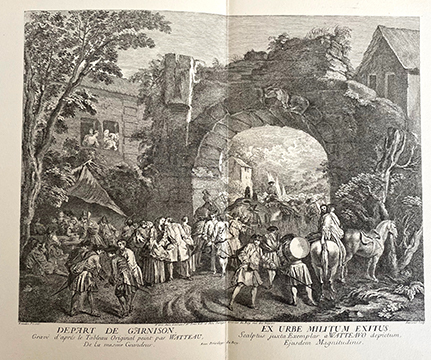
Simon François Ravenet after Watteau, Le Départ de garnison, c. 1737-38, engraving.
Le Départ de garnison was engraved in the same direction by Simon François Ravenet, c. 1737-38. The print was announced for sale in the June 1737 issue of the Mercure de France, p. 1177.
PROVENANCE
Paris, collection of Marin de la Haye (deceased by 1754; fermier général). His sale, Paris, July 1,1754, lot 46: “Un Tableau peint sur toile, représentant un départ de garnison, par Vatteau, de 21 pouces de haut sur 27 pouces de large, dans sa bordure dorée.” According to an annotated copy of the sale catalogue in the Frick Art Reference Library, the painting sold for 300 livres to Ledoux.
Paris, collection of Charles Jean Goury de Grandchamp, known as the marquis de Grandchamp (1732 – 1799; military officer). His sale, November 18ff, 1776 (under the pseudonym of Verrier), lot 87: “ANTOINE VATTEAU . . . Le départ d’une troupe: on voit une défilée passer sous une grande voûte, avec des chevaux chargés de bagages; & sur le devant, plusieurs se faisant des adieux. Ce Tableau, d’une composition riche, extrêment varié, est d’une touche fine, spirituelle, & d’une entente de couleur de grand effet. Largeur 28 pouces; hauteur 22 pouces. T.” Sold for 580 livres to Vautrin (Vautrain), according to an annotated copy of the sale catalogue in the Rijksbureau voor Kunsthistorische Documentatie, but the painting’s subsequent history reveals that Champgrand retained ownership of the picture.
Paris, sale, March 20-24, 1787, collections of Charles Jean Goury de Grandchamp, known as the marquis de Grandchamp, St Maurice, and others, lot 201: “PAR LE MÊME [ANT WATTEAU.] . . . Un Tableau riche de composition, dont le sujet présente le départ d’une armée; on y voit au milieu de la composition le principal corps de troupes défilant sous une arcade, & en avant, sur le premier plan, différens personnages qui se disent des adieux. Il regne dans ce morceau une harmonie & une vigueur de couleur, qui rappelle la belle maniere de cet Artiste. Hauteur 22 pouces, largeur 28 pouces. T.” Bought for 480 livres by Alexandre Joseph Paillet for Langlois.
Paris, with Langlois (dealer).
Paris, with an unnamed brocanteur, rue Saint-Benoît, 1832; reported by Molay-Bacon, Trouvailles et bibelots (1880), 141-42.
Paris, collection of M. Le Gras (professor of drawing in St. Germain). His sale, Paris, Hôtel des ventes, November 25-30, 1839, lot 45: “VATTEAU. Tableau connu par la gravure sous le nom de Décampement. Ce tableau a besoin d’une main habile pour le restaurer.”
SELECT BIBLIOGRAPHY
Hédouin, “Watteau” (1845), cat. 4.
Hédouin, Mosaïque (1856), cat. 5.
Goncourt, L’Art au XVIIIème siècle (1860), 56.
Goncourt, Catalogue raisonné (1875), cat. 59.
Molay-Bacon, Trouvailles et bibelots (1880), 141-42.
Mollet, Watteau (1883), 26, 62.
Dacier, Vuaflart, and Hérold, Jean de Jullienne et les graveurs (1921-29), 1: 54; 2: 44, 46-47, 64, 78, 93, 133, 142 ; 3: cat. 276.
Réau, ”Watteau” (1928), cat. 48.
Adhémar, Watteau (1950), cat. 50.
Dacier, “Catalogue de la vente Verrier” (1953), 307, 329.
Mathey, Watteau, peintures réapparues (1959), 67.
Cailleux, “Four Studies of Soldiers“ (1959), ii, iv, vii.
Macchia and Montagni, L’opera completa di Watteau (1968), cat. 59.
Ferré, Watteau (1972), cat. B 3.
Roland Michel, Watteau (1981), cat. 93.
Roland Michel, Watteau (1984), 170.
Washington, Paris, Berlin, Watteau 1684-1721 (1984), under cat. D26.
Posner, Watteau (1984), 34, 40, 100.
Rosenberg and Prat, Watteau, Catalogue raisonné des dessins (1996), cat. 129, 152, 153, 172, 210, G 8, G. 44, G. 44, G.47.
Wile, Watteau’s Soldiers (2016), 85-87, 89, 92-93, 95, 99.
RELATED DRAWINGS
Several extant drawings can be related to Le Départ de la garnison, and there are as well drawings that are no longer extant studies but which were recorded in the Figures de différents caractères. Given the total number of figures in this monumental composition, these drawings represent only a small percentage.
Exceptionally, eight drawings supposedly for this painting were reported together in the collection of the miniature painter Daniel Saint—a collection with a strong representation of our artist’s work. They were sold together in a single lot at the Saint sale, Paris, May 4ff, 1846, lot 24: “DU MÊME [WATTEAU (Antoine)] . . . Etudes de soldats pour son tableau du depart de garnison, huit dessins à la sanguine.” These eight drawings are particularly noteworthy since there are no comparable groups of studies for a single painting in other early sales. How these drawings came to be together is unknown. It is quite possible that some of the drawings discussed below were in this group.
Both studies of soldiers on a sheet in the Musée Condé (Rosenberg and Prat 153) were used for the painting. The seated man drinking was supposedly employed for the figure at the far left of the engraving. However, in the engraving he sits directly on the ground and his legs extend forward, all of which differs from the Chantilly drawing. The standing soldier looking back over his shoulder as he walks forward served for the man in the foreground of the painting, to the right of center.
The central figure on a sheet in Berlin with three studies of soldiers (Rosenberg and Prat 177) was used for a minor figure near the middle of the composition.
A drawing in Cambridge with three studies of a drummer (Rosenberg Prat 210) is pertinent, but only the drummer at the right of the sheet was employed for our painting, namely for the drummer in the right foreground of the composition.
Perhaps the most remarkable drawing associated with the painting is one in the Ashmolean Museum (Rosenberg and Prat 129). The study was used for the couple at the left, clasping hands and about to kiss. The drawing is remarkable on two counts: first it is rare to find drawings in which Watteau has posed member of the opposite sexes together, even if planning a painting; secondly, it is equally unusual to find him drawing his models in such close conjunction, both physically and emotionally.
In the drawing, the woman is wearing a fontange, a small piece of lace perched atop her head. It was a fashionable item of dress in the late seventeenth and early eighteenth centuries, but it dropped from favor around 1715. Watteau omitted the fontange in the painting, a witness to the change in styles.
Equally intriguing is a lost drawing recorded as plate 112 in the Figures de différents caractères. It shows a soldier and woman riding side saddle astride a horse. Watteau used this group at the right side of the engraving. He introduced certain modifications: the woman’s skirt originally puffed out more and she wore a prominent fontange. In the painting there is no fontange, again a witness to the change in fashion. As just discussed, the posing of two figures together is rarely encountered in Watteau’s preliminary drawings. The woman in the drawing wears a fontange on her head but not in the painting, a second witness to the change in fashion.
REMARKS
Although we have been able to extend the provenance of Le Départ de garnison further into the nineteenth century than was previously known, still, we do not have the painting itself. Even if it were to be found some day, it would evidently not be in good condition. When Molay-Bacon saw the painting in 1832 in the shop of a Parisian antique dealer, it was in poor condition, and when it was auctioned in1839, a skillful restorer was recommended. It is unlikely that this painting will ever resurface but, if it did, it probably would be in a ruinous state.
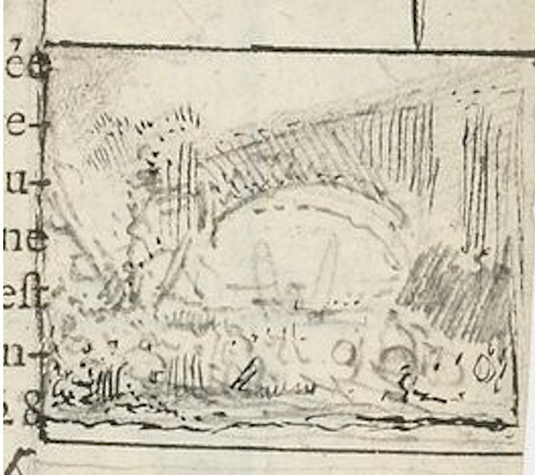
Gabriel de St. Aubin after Watteau, Le Départ de garnison, marginal sketch in the November 18ff, 1776 sale catalogue. Paris, Bibliothèque nationale.
Dacier, Vuaflart, and Hérold noted that the caption on the engraving states, “de la même grandeur que l’estampe,” which would mean that the painting was 42.7 x 56.2 cm. When the painting was sold in 1754 it was measured as 55 x 70 cm, i.e., it was larger than the engraving. Thus these scholars asked whether the engraving might not have shown just the central portion of a larger composition. At the very same time, however, they noted that the St. Aubin sketch showed exactly the composition that Ravenet engraved. Therefore he had not engraved just a central section. Despite their excess of caution and reasoned argument, later scholars—notably Adhémar, followed by Macchia and Montagni—wrongly continued to suggest that the Ravenet engraving records only the central section of Watteau’s painting.
The dating of the painting, as with all Watteau’s military subjects, had generally centered around his trip to Valenciennes, a trip which he made in late 1710 and not in 1709 as had been previously thought. Adhémar proposed a date of 1710-1711 for Le Départ de la garnison, as did Mathey. Macchia and Montagni as well as Roland Michel preferred 1710, although the latter author later proposed 1712. Posner also suggested a date around 1712 or later. Cailleux dated the painting 1712-1714. Rosenberg and Prat dated some of the preliminary figure studies to c. 1711-12 and dated the painting to 1714. Grasselli placed the painting as late as 1715-1716, and acknowledged the revolutionary nature of her chronology.
Given the large number of preliminary drawings and the painting’s well-established provenance in the eighteenth century, almost all scholars have accepted the authenticity of Le Départ de garnison. The exceptions are Ferré and Saint-Paulien, who proposed that the painting was by Bonaventure de Bar, and that after this artist’s death in 1729 the painting was wrongly attributed to Watteau. However, there is insufficient stylistic relationship between this painting and de Bar’s work.
